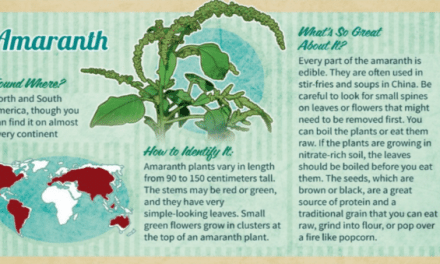Most of us love outdoors skills pursuits such as hunting, fishing, camping, hiking and canoeing. Yet even though we consider ourselves “outdoor types,” few of us possess the skills and knowledge that were once considered basic by all true woodsmen. Could you, for example, gather and cook wild foods without modern accoutrements? Do you know how to improvise or repair tools in the backcountry? Would you be able to find your way back to a vehicle or camp without a GPS or map? If your life depended on it, could you start a fire with a single match?
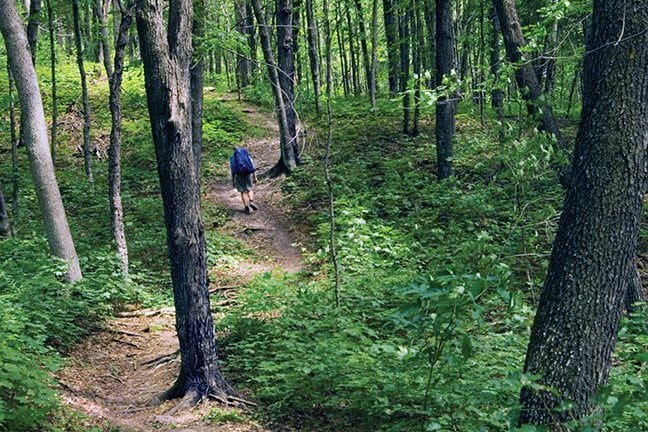
A backpacker hikes along a wooded trail. What to pack is an important outdoors skill.
Unfortunately, knowledge of these “woodsman’s ways” is increasingly uncommon. If forced by calamity into a survival situation, many people would find it difficult to stay warm, well fed and healthy. Some might even perish.
Learning the woodsmanship skills presented in this column not only is an insurance policy, but it’s also a way of getting back in touch with nature. It can be an adventure in which the reader discovers not only how to survive in unexpected situations, but how to live well whether fishing solo on a backcountry river, hunting with friends in a wilderness area or camping with family in a park near home. Those who study these tips will discover they can do things they never dreamed they could do. And at particularly high moments, they will feel a real connection to the natural world around them.
BUILD AN EMERGENCY SHELTER
Bough structures that reflect a fire’s warmth, serve as windbreaks, and provide overhead shelter are important emergency shelters. They can be erected without tools in an hour in an area with downed timber — less if you find a makeshift ridgepole such as a leaning tree to support the boughs.
Step One: Wedge a ridgepole (a horizontal crosspiece) into the lower forks of two closely growing trees (one end can rest on the ground if necessary), or support the ends of the ridgepole with tripods of upright poles lashed together near the top.
Step Two: Tilt branches or poles against the ridgepole to make a frame. To strengthen it, interlace limber boughs through the poles at right angles.
Step Three: Thatch the lean-to with slabs of bark or leafy or pine-needle branches, weaving them into the framework. Chink with sod, moss or snow to further insulate.
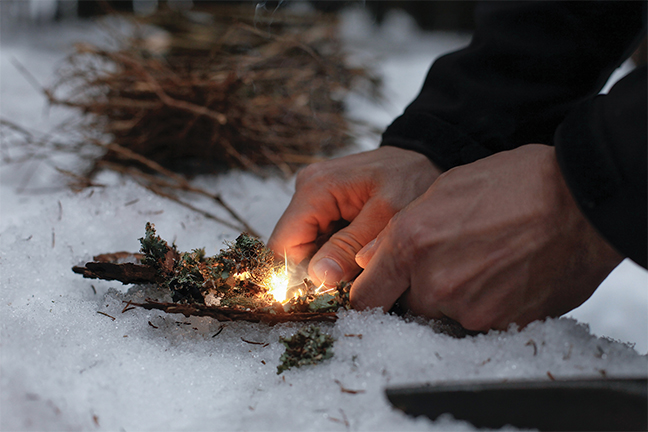
Starting a campfire
ONE-MATCH FIRE
Lighting a fire should be accomplished with a single match if possible. Even when plenty of matches are at hand, this skill may someday mean the difference between a warmly comfortable camp and a chilly, miserable one.
Ordinary wooden matches are best and should be kept in a waterproof, unbreakable container. Place a softball-sized piece of tinder on a slab of dry bark or the ground. Good tinder ingredients include lint (check your pockets and belly button), cotton threads, dry-wood powder, unraveled string, bird or mouse nests, dry splinters pounded between two rocks, dry shredded bark or pine needles, and slivers of fat pine.
After the tinder is laid, pile a handful of small, dry twigs (preferably evergreen twigs) above this. Over this nucleus, lean a few slightly larger seasoned branches. Also in teepee fashion, so ample oxygen will reach all parts of the heap, lay up some big pieces of dead wood.
With the fire pile sheltered from wind and rain, ignite the tinder so the flames will eat into the heart of the pile. When the fire gets going well, you can shape it any way you want.

The two stars at the edge of the Big Dipper’s cup point to the North Star.
NORTH STAR GUIDE
If you are in the northern hemisphere, you can use the North Star to locate north. To find the North Star, locate the Big Dipper, then follow the line made by the two stars that form the front end (opposite the handle) of its “cup.” These point to the North Star (Polaris), which always lies directly over north on the horizon.
COOKED ON A SPIT
Spit roasting — turning a hunk of spitted meat over campfire flames — is one of the oldest and simplest cooking methods, ideal for preparing anything from a haunch of venison to a bluegill. The spit is a long, straight, green tree limb, preferably one with a fork on one end that can serve as a handle for turning. Choose wood such as green oak or hickory that won’t impart poor taste to the food. Shave the spit to flatten it along two opposite sides (this prevents food from rotating on the stick) and suspend it across the coals atop two forked sticks driven into the ground on opposite sides of the fire at an appropriate height. Turn the food while it broils to taste, basting with drippings caught in a pan or curved slab of bark placed beneath it.
GET YOUR BEARINGS
One way to determine direction without the aid of a compass is to drive a straight 3-foot stick into the ground in a sunny location and set a stone at the tip of its shadow. Wait 20 minutes and then place another rock where the tip of the shadow has moved. The first marker indicates the west end of a line running between the two rocks; the second marks the east.
LEAK REPAIR
A leaky canoe or boat often can be temporarily repaired using a favorite old-timer’s trick. Using a small stick, apply pine pitch to the hole or leaky seam. Pine pitch, the sticky gum found on pine trees, is durable and waterproof.
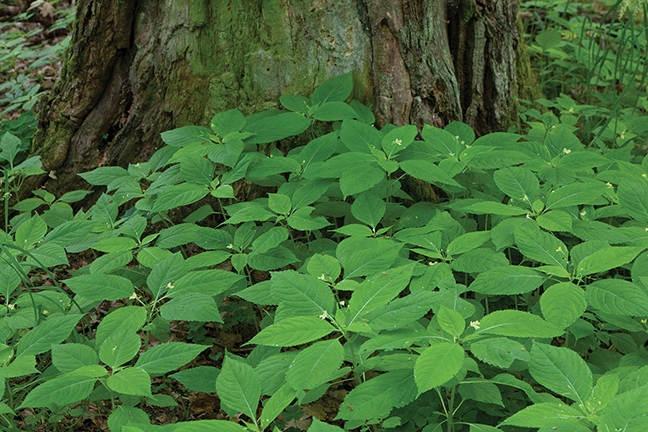
Touch-me-not plants can be used as a rash remedy.
RASH REMEDY
Those who are allergic to poison ivy and poison oak know the itchy rash caused by these plants can drive you bonkers. Fortunately, nature provides a remedy. Juice from the leaves and stems of the wide-ranging jewelweed plant (also known as impatiens and touch-me-not) provides relief when rubbed on the affected area and allowed to dry. Some practitioners boil cut-up leaves, stems and flowers then swab the blisters with the resulting orange decoction, a treatment almost as effective as cortisone creams for itch relief.
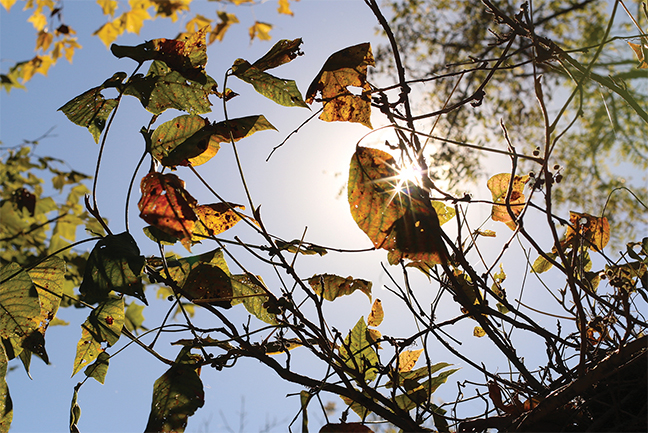
Black walnut leaves can be used to make a natural insect repellent.
BUGS OFF
The leaves of black walnut trees contain juglone, which has pesticidal properties. This is why crushed walnut leaves can be used as a natural insect repellent to keep away flies, fleas, bedbugs and other pests. The leaves of the elderberry and sweet fern — when rubbed on the skin — also work as a “poor man’s” insect repellent.
SIX-LEGGED THERMOMETER
Once upon a time, some enterprising outdoorsman discovered the cricket makes a pretty handy outdoor thermometer. If you count the number of chirps a cricket makes in one minute, then add 40, the sum will be very close to the ambient temperature.
PRICKLY DINNER
Covered as it is with all those quills, the porcupine doesn’t look like it would be a good thing to eat. But porcupines are said to be quite delicious and actually make nutritious survival food. These plodding mammals can be easily approached and killed with a club, a trait that has saved the lives of many lost hunters and trappers. Place the porcupine on its back to skin it, using care to remove the hide after making a throat-to-tail incision along the quill-free belly.
CRITTER GITTER
Fish and frogs often are easy to find when you’re looking for dinner outdoors, but these slippery critters can be hard to hold if you manage to grab one. A jawed spear provides a better way of capturing them. Split one end of a long green willow pole or other sapling 6 to 8 inches on one end. Carve sharp, rear-angling teeth into each flat side in the split. Use cordage to bind the split’s upper end so it won’t split farther. Open the “jaws,” and prop them open with a twig strong enough to separate them 2 or 3 inches. When you thrust the spear down over a fish or critter, the twig is knocked out, and the jaws snap shut, holding the animal.
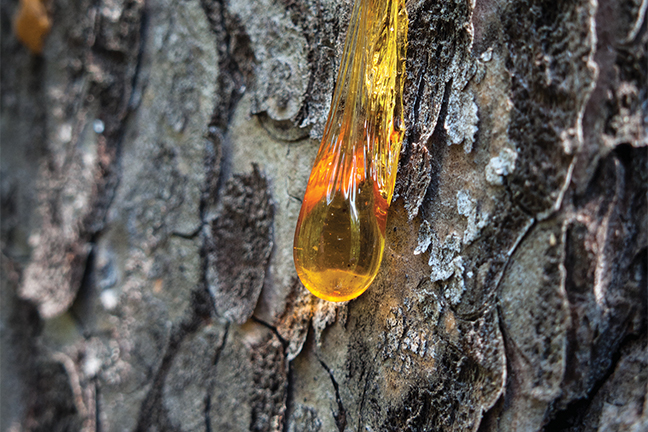
Pine pitch can be used to repair small leaks in boats.
NATURE’S POT SCRUBBER AND SANDPAPER
The horsetail plant, also known as scouring rush, grows in dense stands in moist soils throughout much of North America. The stems are coated with abrasive silicates, which make them useful for scouring (cleaning) pots, polishing metal and wood, and as fine sandpaper. For best use, the stems are first bleached by repeated wetting and drying in the sun.
CAREFUL WHAT YOU EAT
Some wild mushrooms — morels for example, and chanterelles — can be delicious and nutritious. But if you’re thinking about making a meal of wild mushrooms, don’t forget this old proverb: “All mushrooms are edible, but sometimes only once.” Unless you’re absolutely certain you can distinguish edible mushrooms from poisonous or hallucinogenic varieties, you should not eat wild mushrooms at all.
TEA FOR THE TAKING
Tea can be made by steeping leaves or roots of many wild plants in hot water. Some have medicinal properties, but most are used simply because they taste good. (Note: on public land, check regulations on picking native plants before you plan your trip.)
* Sassafras: Make tea by steeping the aromatic roots in hot water. This has long been used as a “spring tonic.” One of nature’s most flavorful drinks.
* Wild strawberry: Tea made from the leaves is exceptionally high in vitamin C.
* Blackberry/dewberry: Leaves can be steeped to make an excellent tea long used as a remedy for diarrhea, sore throat and rashes. Sweeten with honey.
* Bee balm, or Oswego tea: Leaves of this wild mint make an invigorating tea said to induce sleep.
* Sweet goldenrod: The anise-scented leaves can be used fresh or dried to make a healthful tea that has been used as a digestive stimulant, for stomach cramps, coughs, colds and more.
WAYS TO USE A WALKING STAFF
A walking staff is one of the handiest tools a woodsman can carry. With a staff in hand, you can carry heavy loads across steep slopes, rocks and bogs with confidence. When crossing marshy areas or streams, use a staff to probe for hidden obstructions and deep spots. The staff holds back bushes, stinging plants, spider webs and other things in your path. Use it as a support for a camp tarp or wash line. Reach with it to retrieve food sacks hung out of reach of bears. Use it to lift a hot pot off the fire or replace a broken tent pole. Mark it with feet and inches for measuring things in the field. Reach a friend who’s tumbled into the water, or roll two staffs in a blanket to make a stretcher. A staff can support you if you fall through ice. Or you can use it, if needed, for a crutch.
WARMTH TIMES THREE
In a survival situation, or when you or others are dangerously wet and cold, build three small fires and get in the middle. This allows you to share the heat and stay warm front and back better than you can with a single large fire. Also, three fires is a distress signal (easily seen by air searchers) just like three gunshots or three blasts on a whistle.
IMPROVISED LURES
Do you have fish hooks and line but no bait with you? A strip of colored cloth, a feather, an earring or even a dinner spoon can sometimes be rigged on a hook to improvise a workable fishing lure.
WIND INDICATORS
Which way is the breeze blowing? Hunters need to know so that they can take a stand downwind from their quarry. A good way to tell employs the fluffy seeds from a cattail, dandelion, milkweed or thistle plant. Collect the seeds when you see them and place them in a sealable plastic bag you can keep in the pocket of your hunting coat. Then test the wind direction by dropping some fluff into the air and watching which way it goes. The seeds are natural, so they have no strange smell like the powders used by some hunters.
The post Outdoors Skills: Become a Real Woodsman appeared first on Game & Fish.














